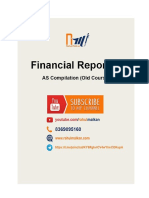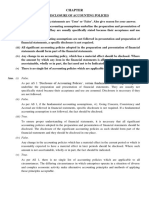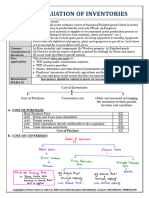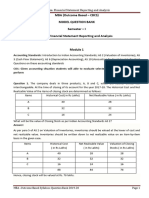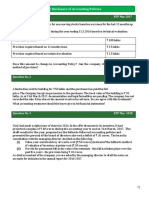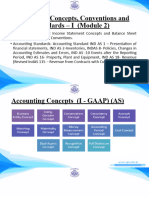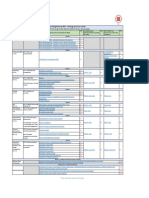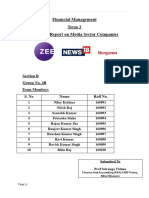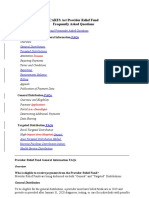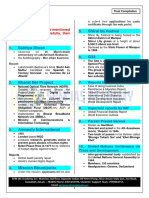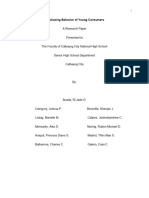CMA INTER AS Notes
Uploaded by
chittis.420CMA INTER AS Notes
Uploaded by
chittis.420CMA Inter Corporate Accounting AVINASH LALA CLASSES
AVINASH LALA CLASSES
CMA INTER
Corporate ACCOUTNING
Ind AS Marathon
BY: CA. AVINASH LALA
Corporate Accounting Ind AS 1 CA. AVINASH LALA
CMA Inter Corporate Accounting AVINASH LALA CLASSES
Question-1
The following particulars are presented by M Ltd. (deals in clothing) as on 31.3.2021:
Compute the value of stock as per Ind AS 2.
Stock held by M Ltd.:
Cost Price ₹ 10,550
Net Realisable Value ₹ 11,500
The details of such stocks were:
Particulars Cost Price (₹) Net Realizable Value (₹)
Cotton 5,600 4,960
Woolen 3,450 4,540
Synthetic 1,500 2,000
Total 10,550 11,500
Solution
Valuation of Inventory as per Ind AS 2
As per Ind AS 2, inventories are usually valued at lower of cost and net realisable value on an
item-by-item basis.
Cost Price (₹) Net Realizable Value (₹) Value of Closing Stock (₹)
Cotton 5,600 4,960 4,960
Woolen 3,450 4,540 3,450
Synthetic 1,500 2,000 1,500
10,550 11,500 9,910
Hence, value of stock will be considered for ₹ 9,910 as per Ind AS 2.
Question-2
Sonar Bhandar deals in old colour TVs. It has 4 TVs the particulars of which are given below:
You are asked to compute the value of inventory to be included, in Balance Sheet for the year
ended 31st March 2021.
TVs Onida (₹) Philips (₹) EC (₹) Sony (₹) Total (₹)
Cost Price 10,000 20,000 35,000 50,000 1,15,000
Expenses incurred to bring into salable 3,000 2,000 5,000 - 10,000
conditions
Net Realizable Value 18,000 30,000 36,000 55,000 1,39,000
Corporate Accounting Ind AS 3 CA. AVINASH LALA
CMA Inter Corporate Accounting AVINASH LALA CLASSES
Solution
As per Ind AS 2, Inventories, inventories should be valued at the lower of cost or net realisable
value on an item-by-item basis, which are:
TVs Onida (₹) Philips (₹) EC (₹) Sony (₹) Total (₹)
Cost Price (including expenses) 13,000 22,000 40,000 50,000 1,25,000
Net Realizable Value 18,000 30,000 36,000 55,000 1,39,000
Value of Stock 13,000 22,000 36,000 50,000 1,21,000
Value of inventory to be included in Balance Sheet will be ₹1,21,000.
Question-3
The total stock of A Ltd. as on 31.3.2021 was ₹5,00,000 of which stock amounting to ₹31,000
were not ascertained as per Ind AS 2.
Compute the value of the said stocks as per Ind AS 2 for inclusion in financial statements as
on that date.
Type of Cost of Production Selling and Distribution Estimated
Product Materials Expenses incurred expense to be incurred Selling Price
(₹) (₹) (₹) (₹)
P 10,000 2,000 1,000 15,000
S 5,000 --- 500 4,500
T 12,000 3,000 2,000 18,000
27,000 5,000 3,500 37,500
Solution
As per Ind AS 2, inventories are usually written-down to net realisable value on item-by-item
basis. Thus, value of stock will be computed as:
Type of Cost Price Net Realizable Value (excluding Value of Stock to be
Product (including Production Selling & Distribution Expenses taken (lower of Cost
Exp.) from Selling Price) Price & Net Realizable
(₹) (₹) Value) (₹)
P 12,000 14,000 12,000
(10,000 + 2,000) (15,000 – 1,000)
S 5,000 4,000 4,000
(4,500 – 500)
T 15,000 16,000 15,000
(12,000 + 3,000) (18,000 – 2,000)
31,000
Corporate Accounting Ind AS 4 CA. AVINASH LALA
CMA Inter Corporate Accounting AVINASH LALA CLASSES
So, Value of Stock will be ₹31,000 for inclusion in financial statements as per Ind AS 2.
Question-4
At the end of its financial year, Company P has 100 units of inventory on hand recorded at a
carrying amount of ₹ 10 per unit. The current market price is ₹ 8 per unit at which these units
can be sold. Company P has a firm sales contract with Company Q to sell 60 units at ₹ 11 per
unit, which cannot be settled net. Estimated incremental selling cost is ₹ 1 per unit.
Compute Net Realisable Value (NRV) of the inventory of Company P.
Question-5
Calculate the value of Work in progress at the end of the year from the following information
Amount (₹)
Cost of Material 1,00,000
Conversion cost incurred till date 50,000
Further estimated cost to complete the goods 30,000
Net Realisable Value of the finished goods is ₹ 1,70,000.
Question-6
AB Ltd. has finished goods costing ₹ 3,00,000 whose Net Realisable Value is-
Case -a: ₹ 3,14,000
Case -b: ₹ 3,00,000
Case -c: ₹ 2,89,000
Raw Material also is in stock. Cost Price is ₹ 2,10,000. Replacement Price is ₹ 1,90,000.
Calculate the value of Inventories.
Question-7
Cost of Production of product M is given below:
Material per unit ₹ 120
Wages per unit ₹ 80
Overhead per unit ₹ 50
As on the balance sheet date, the replacement cost of raw material is ₹ 105 per unit. There
were 2000 units of raw material on 31.03.2021.
Calculate the value of closing stock of raw material in following conditions:
i. If finished product is sold at the rate of ₹270 per unit, what will be value of closing stock
of raw material?
ii. If finished product is sold at the rate of ₹ 235 per unit, what will be value of closing stock
of raw material?
Question-8
X Ltd. presented the following particulars as on 31.3.2021 on the total cost of product:
Corporate Accounting Ind AS 5 CA. AVINASH LALA
CMA Inter Corporate Accounting AVINASH LALA CLASSES
Particulars Cost per unit (₹)
Cost of materials (₹12 each) 50
Manufacturing inputs 30
Total Cost 80
Profit 20
Selling Price 100
On 31.3.2021, selling price has gone down suddenly from ₹ 100 to ₹ 70. Price of raw material
has also gone down to ₹ 8 each. X Ltd. had in its stock 6,000, units of materials which was
bought as per the above rate on the same date. Compute the value of stock as on 31.03.2021.
Solution
As per Ind AS 2, when there has been a decline in the price of materials and it is estimated
that the cost of the finished products will exceed net realisable value, the materials are
written-down to net realisable value. In such circumstances, the replacement cost of the
materials may be the best available measure of their net realisable value. In this case, the
total cost of ₹80 exceeds the net realisable value, i.e., selling price, of ₹70 (as the price of raw
materials had gone down from ₹12 to ₹8). So, inventories should be valued @ ₹70 each and,
as such, the total value of stock would be ₹4,20,000 (i.e., 6,000 units x ₹70).
Question-9
Sharp Trading Inc. purchases motorcycles from various countries and exports them to Europe.
Sharp Trading has incurred these expenses during 2023:
a. Cost of purchases (based on vendors’ invoices) ₹ 5,00,000
b. Trade discounts on purchases ₹ 10,000
c. Import duties ₹ 200
d. Freight and insurance on purchases ₹ 250
e. Other handling costs relating to imports ₹ 100
f. Salaries of accounting department ₹ 15,000
g. Brokerage commission payable to indenting agents for arranging imports ₹ 300
h. Sales commission payable to sales agents ₹ 150
i. After-sales warranty costs ₹ 600
Advise as if which of the above item is to be included in the cost of inventory and wants you
to calculate cost of inventory as per Ind AS 2.
Solution
Items (a), (b), (c), (d), (e), and (g) are permitted to be included in the cost of inventory since
these elements contribute to cost of purchase, cost of conversion and other costs incurred in
bringing the inventories to their present location and condition, as per Ind AS 2
Statement showing cost of inventory
Corporate Accounting Ind AS 6 CA. AVINASH LALA
CMA Inter Corporate Accounting AVINASH LALA CLASSES
Amount (₹)
Cost of purchases (based on vendors’ invoices) 5,00,000
Trade discounts on purchases (10,000)
Import duties 200
Freight and insurance on purchases 250
Other handling costs relating to imports 100
Brokerage commission payable to indenting agents for arranging imports 300
Cost of inventory under Ind AS 2 4,90,850
Note: Salaries of accounting department, sales commission, and after-sales warranty costs
are not considered as part of cost of inventory under Ind AS 2.
Question-10
ABC Ltd. produced 20,00,000 units of product A during the year 2020-21 per unit cost is as
follows:
Raw Material ₹ 100
Direct wages ₹ 50
Direct Expenses ₹2
Production overhead is ₹ 40,00,000 of which 40% is fixed. The company sold 16,00,000 units
and 4,00,000 units were in stock as on 31/3/2021. Normal capacity is 10,00,000 units.
Calculate the value of closing stock.
Question-11
State with reference to accounting standards how will you value the inventories in the
following cases:
i. Raw materials were purchased at ₹100 per kg. Prices of raw materials are on the
decline. The finished goods in which the raw materials is incorporated is expected to be
sold at below cost. 10,000 Kgs. of raw materials is on stock at the year end. Replacement
cost is ₹80 per kg.
ii. In a production process, normal waste is 5% of input. 5,000 MT of input were put in
process resulting in a wastage of 300 MT. Cost per MT of input is ₹1,000. The entire
quantity of waste is on stock at the year-end.
iii. Per kg of finished goods consisted of:
Amount (₹)
Material Cost 100
Direct Labour 20
Direct Variable Production Overhead 10
Corporate Accounting Ind AS 7 CA. AVINASH LALA
CMA Inter Corporate Accounting AVINASH LALA CLASSES
Fixed production charges for the year on normal capacity of one lakh kg is ₹10 lakhs. 2,000 kg
of finished goods are on stock at the year end.
Solution
i. As per Ind AS 2, materials and other supplies held for use in the production of inventories
are not written- down below cost if the finished products in which they will be
incorporated are expected to be sold at or above cost. However, when there has been a
decline in the price of materials and it is estimated that the cost of the finished products
will exceed net realisable value, the materials are written down to net realisable value.
In this case, cost of raw material was ₹100 per kg. But the finished goods (which are
produced from the said raw materials) are expected to realise at below the Cost Price.
So, the value of 10,000 kg of raw materials will be @ ₹80 per kg (i.e., on the basis of
replacement cost) ₹8,00,000.
ii. As per Ind AS 2, in determining the cost of inventories it is appropriate to exclude
abnormal amount of wasted materials, labour or other production expenses in the period
in which they are incurred.
Input 5,000 MT; Normal loss 5% of 5,000 MT = 250 MT.
Wastage 300 MT;
Abnormal loss = 300 MT – 250 MT = 50 MT
Revised Cost of one MT of input after adjusting Normal Loss= (5,000 x 1,000)/4,750 =
1,052.6
So, cost of 250 MT should be included in the cost of finished goods. But the cost of entire
abnormal wastage (i.e., 1,052.6 x ₹50) ₹52,630 should be charged against Profit and Loss
of the company.
iii. As per Ind AS 2, the allocation of fixed production overheads for the purpose of their
inclusion in the costs of conversion is based on the normal capacity of the production
facilities.
Thus, the cost of finished goods per kg will be:
Cost per kg = Direct Material + Direct Labour + Variable Production overhead + Fixed
production overhead
= ₹100 + ₹20 + ₹10 + ₹10 = ₹140.
Note: Fixed Production overhead per kg = 10,00,000/1,00,000 = ₹10 per kg.
Therefore, value of closing stock of finished goods will be ₹2,80,000 (i.e., 2,000 kg x ₹140).
Question-12
From the following information presented by P Ltd. ascertain the value of stock to be included
in Balance Sheet: Cost Price of certain stock amounted to ₹60,000; being obsolete, it can be
used for production purposes after incurring ₹10,000 for modification. The same could be
used as a raw material for an existing product, the purchase price for the same amounts to
₹40,000.
Corporate Accounting Ind AS 8 CA. AVINASH LALA
CMA Inter Corporate Accounting AVINASH LALA CLASSES
Solution
Cost price of the product (given) ₹60,000.
Net Realisable Value of the product = ₹40,000 – ₹10,000 = ₹30,000.
Inventories are valued at lower of Cost and Net Realisable value. Hence, ₹30,000 should be
treated as the Value of Stock to be included in Balance Sheet.
Question-13
How will you deal with the following situation?
“A company deals in purchase and sale of timber and has included notional interest charges
calculated (on the paid-up share capital and free reserves) in the value of stock of timber as
at the Balance Sheet date as part of cost of holding the timber”.
Solution
According to Ind AS 2, Inventories, interest and other borrowing costs are usually considered
as not relating to bringing the inventories to their present location and condition and are,
therefore, usually not included in the cost of inventories. Hence, the valuation of closing stock
of timber cannot be considered as it is not in conformity with Ind AS 2.
Question-14
Z Co. Ltd. purchased goods at the cost of ₹ 40 lakhs in October 2020. Till March 2021, 75% of
the stocks were sold. The company wants to disclose closing stock at ₹10 lakhs. The expected
sales value is ₹11 lakhs and a commission at 10% on sale is payable to the agent. What is the
correct closing stock to be disclosed as at 31.3.2021?
Solution
The stand of the company to disclose the closing stock at ₹10 lakhs is not in line with Ind AS
2. As per Ind AS 2, inventory should be valued as per cost price or net realisable value,
whichever is lower. In the given problem, cost price is ₹10 lakhs, but the net realisable value
is ₹11,00,000 x 90% = ₹9,90,000. So, the value of closing inventory should be taken as
₹9,90,000 being the lower.
Question-15
How would you deal with the following in the annual accounts of a company for the year
ended 31.3.2021?
“The company has to pay delayed cotton clearing charges over and above the negotiated
price for asking delayed delivery of cotton from the supplier’s godown. Up to 2019-20, the
company has regularly included such charges in the valuation of closing stock. This being in
the nature of interest the company has decided to exclude it from closing stock valuation for
the year 2020-21. This would result into decrease in profit by ₹7.60 lakhs.”
Corporate Accounting Ind AS 9 CA. AVINASH LALA
CMA Inter Corporate Accounting AVINASH LALA CLASSES
Solution
As per Ind AS 2, Inventories, interest and other borrowing costs are usually considered as not
relating to bringing the inventories to their present location and condition and are, therefore,
usually not included in the cost of inventories. Thus, it becomes quite clear that delayed
cotton clearing charges which were treated in the nature of interest must not be included
while valuing closing stock as per the provision of Ind AS 2 and it is not in compliance with Ind
AS 2 which was done up to 2019-20.
But from year 2020-21, the company decided to change the earlier view i.e. they decided to
exclude the same from the valuation of closing stock which is, no doubt, in compliance with
Ind AS 2.
As a result of change in accounting policy regarding valuation of stock, the profit was reduced
by is. ₹7.60 lakhs which must be disclosed in the financial statement.
Question-16
In a manufacturing process of Mars Ltd, one by-product BP emerges besides two main
products MP1 and MP2 apart from scrap. Details of cost of production process are here under:
Item Unit Amount (₹) Output Closing Stock
31.03.2025
Raw material 14,500 1,50,000 MP1 - 5,000 units 250
Wages - 90,000 MP2 - 4,000 units 100
Fixed overhead - 65,000 BP- 2,000 units
Variable overhead - 50,000
Average market price of MP1 and MP2 is ₹ 60 per unit and ₹ 50 per unit respectively, by-
product is sold @ ₹ 20 per unit. There is a profit of ₹ 5,000 on sale of by-product after incurring
separate processing charges of ₹ 8,000 and packing charges of ₹ 2,000, ₹ 5,000 was realised
from sale of scrap.
Calculate the value of closing stock of MP1 and MP2 as on 31.03.2025.
Solution
As per Ind AS 2 ‘Inventories’, most by-products as well as scrap or waste materials, by their
nature, are immaterial. They are often measured at net realisable value and this value is
deducted from the cost of the main product.
1. Calculation of NRV of By-product BP
Particulars Amount (₹)
Selling price of by-product (2,000 units x 20 per unit) 40,000
Less: Separate processing charges of by- product BP (8,000)
Packing charges (2,000)
Corporate Accounting Ind AS 10 CA. AVINASH LALA
CMA Inter Corporate Accounting AVINASH LALA CLASSES
Net realisable value of by-product BP 30,000
2. Calculation of cost of conversion for allocation between joint products MP1 and MP2
Particulars Amount (₹)
Raw material 1,50,000
Wages 90,000
Fixed overhead 65,000
Variable overhead 50,000
Less: NRV of by-product BP (See calculation 1) 30,000
Sale value of scrap 5,000 (35,000)
Joint cost to be allocated between MP1 and MP2 3,20,000
3. Determination of “basis for allocation” and allocation of joint cost to MP1 and MP2
MP I MP 2
Output in units (a) 5,000 4,000
Sales price per unit (b) 60 50
Sales value (a x b) 3,00,000 2,00,000
Ratio of allocation 3 2
Joint cost of 3,20,000 allocated in the ratio of 3:2 (c) 1,92,000 1,28,000
Cost per unit [c/a] 38.4 32
4. Determination of value of closing stock of MP1 and MP2
Particulars MP I MP 2
Closing stock in units 250 units 100 units
Cost per unit 38.4 32
Value of closing stock 9,600 3,200
Question-17
On 31 March 2021, the inventory of ABC includes spare parts which it had been supplying to
a number of different customers for some years. The cost of the spare parts was ₹ 10 million
and based on retail prices at 31 March 2021, the expected selling price of the spare parts is ₹
12 million. On 15 April 2021, due to market fluctuations, expected selling price of the spare
parts in stock is reduced to ₹ 8 million. The estimated selling expense required to make the
sales would ₹ 0.5 million. Financial statements were approved by the Board of Directors on
20th April 2021.
As at 31st March 2022, Directors noted that such inventory is still unsold and lying in the
warehouse of the company. Directors believe that inventory is in a saleable condition and
Corporate Accounting Ind AS 11 CA. AVINASH LALA
CMA Inter Corporate Accounting AVINASH LALA CLASSES
active marketing would result in an immediate sale. Since the market conditions have
improved, estimated selling price of inventory is ₹ 11 million and estimated selling expenses
are same ₹ 0.5 million.
Determine the value inventory at the following dates:
a. 31st March 2021
b. 31st March 2022
Solution
As per Ind AS 2 ‘Inventories’, inventory is measured at lower of ‘cost’ or ‘net realisable value’.
Further, as per Ind AS 10: ‘Events after Balance Sheet Date’, decline in net realisable value
below cost provides additional evidence of events occurring at the balance sheet date and
hence shall be considered as ‘adjusting events’.
In the given case, for valuation of inventory as on 31 March 20X1, cost of inventory would be
₹ 10 million and net realisable value would be ₹ 7.5 million (i.e. Expected selling price ₹ 8
million - estimated selling expenses 0.5 million). Accordingly, inventory shall be measured at
₹ 7.5 million i.e. lower of cost and net realisable value. Therefore, inventory write down of ₹
2.5 million would be recorded in income statement of that year.
As per para 33 of Ind AS 2, a new assessment is made of net realisable value in each
subsequent period. It inter alia states that if there is increase in net realisable value because
of changed economic circumstances, the amount of write down is reversed so that new
carrying amount is the lower of the cost and the revised net realisable value. Accordingly, as
at 31 March 2022, again inventory would be valued at cost or net realisable value whichever
is lower. In the present case, cost is ₹ 10 million and net realisable value would be ₹ 10.5
million (i.e. expected selling price ₹ 11 million – estimated selling expense ₹ 0.5 million).
Accordingly, inventory would be recorded at 10 million and inventory write down carried out
in previous year for ₹ 2.5 million shall be reversed.
Corporate Accounting Ind AS 12 CA. AVINASH LALA
CMA Inter Corporate Accounting AVINASH LALA CLASSES
Question-1
X Ltd. finalized its accounts on 31.03.2021. However, the financial statements were approved
by the Board on 20.05.2021. An accident occurred in the premises of X Ltd. on 30.05.2021
and properties worth ₹50 lakh has been lost. Will it be considered as an event after the
reporting period as per the scope of Ind AS 10?
Solution
As per Ind AS 10, events occurring after the end of the reporting period but before the
financial statements are approved by the BOD are not regarded as ‘events after the reporting
period’. Since the accident took place after the financial statements have been approved, the
event should not be treated as events after the reporting period.
Question-2
A Ltd. closed its accounting year on 31/03/2021 and the accounts for that period were
considered and approved by the board of directors on 20th May, 2021. The company was
engaged in boring tunnels for metro railway. While doing the boring work on 01/06/2021 it
hit an aquifer and as a result 18 building were damaged. It was estimated that there would
be extra cost to the tune of ₹15 crores. You are required to state with reasons, how it would
be dealt with in the financial statements for the year ended 31.03.2021.
Solution
Ind AS 10 defines ‘events after the reporting date’ are those ‘significant events, both
favourable and unfavourable, that occur between the balance sheet date and the date on
which financial statements are approved by the Board of Directors’. In this case the incidence,
which was expected to push cost, became evident after the date of approval of the accounts.
So that was not an ‘event after the reporting date’ as per Ind AS 10. However, this maybe
mentioned in the Director’s Report.
Question-3
While preparing its final accounts for the year ended 31st March, 2021, a company made a
provision for doubtful debts @ 5% of its total debtors. In the last week of February 2021, a
debtor for ₹20 lakh suffered heavy loss and subsequently became insolvent in April, 2021.
Can the company provide the full loss out of the insolvency of the debtor in the final accounts
for the year ended on 31.03.2021?
Corporate Accounting Ind AS 13 CA. AVINASH LALA
CMA Inter Corporate Accounting AVINASH LALA CLASSES
Solution
As per Ind AS 10, for ‘events after the reporting date’, if circumstances were existing on the
balance sheet date, adjustments should be made in accounts. In the given case, circumstances
were pre-existing and the event in April, 2021 only confirms the same. Hence, it is adjustable
event. Hence, the company can provide the full loss out of the insolvency of the debtor in the
final accounts for the year ended on 31.03.2021.
Question-4
The company has inventory of 100 finished cars on 31st March, 2022, which are having a cost
of 4,00,000 each. On 30th April, 2022, as per the new government rules, higher road tax and
penalties are to be paid by the buyers for such cars (which were already expected to come)
and hence the selling price of a car has come down and the demand for such cars has dropped
drastically. The selling price has come down to ₹ 3,00,000 each. The financial statements of
the company for the year 2021-2022 are not yet approved. Should the company value its
stock at 4,00,000 each or should it value at ₹ 3,00,000 each? Ignore estimated costs necessary
to make the sale.
Solution
Events after the reporting period provide the evidence about the net realisable value of the
cars at the end of the reporting period and, therefore, the amount of ₹ 3,00,000 should be
considered for the valuation of stock.
Question-5
A case is going on between ABC Ltd., and GST department on claiming some exemption for
the year 2021-2022. The court issued the order on 15th April, 2022 and rejected the claim of
the company. Accordingly, the company is liable to pay additional tax. The financial
statements of the company for the year 2021-2022 have been approved on 15th May, 2022.
Should the company account for such tax in the year 2021-2022 or should it account for the
same in the year 2022-2023?
Solution
An event after the reporting period is an adjusting event, if it provides evidence of a condition
existing at the end of the reporting period. Here, this condition is satisfied. Court order
received after the reporting period (but before the financial statements are approved)
provides evidence of the liability existing at the end of the reporting period. Therefore, the
event will be considered as an adjusting event and, accordingly, the amounts will be adjusted
in financial statements for 2021-2022.
Question-6
B Ltd. supplies parts to a car manufacturer in respect of a particular model of car. On the
reporting date, B Ltd. has a high level of inventory of parts due to low order levels. After the
reporting date but before the date of approval of the financial statements, the car
Corporate Accounting Ind AS 14 CA. AVINASH LALA
CMA Inter Corporate Accounting AVINASH LALA CLASSES
manufacturer announces that the specific model will no longer be produced. There is no
alternative market for the inventory. Should B Ltd. write-down of inventory to net realizable
value and adjust the inventory reported on the reporting date?
Solution
Estimates of net realizable value are based on the most reliable evidence available at the time
the estimates are made. These estimates consider fluctuations of price or cost directly
relating to events occurring after the end of the period to the extent that such events confirm
conditions existing at the end of the period. This inventory should be written down to net
realizable value, the high inventory levels indicated slow demand from the manufacturer. The
post balance sheet announcement confirmed the over-supply at year end.
Question-7
Prior to the approval of the financial statements but subsequent to the balance sheet date, C
Ltd. in trading difficulties obtained a valuation of its properties for the purpose of providing
additional security to its bankers. C Ltd. is also considering selling certain properties to
generate additional cash. The amount estimated by the valuer is materially lower than the
carrying amount attributed to the properties at the balance sheet date based on the last
impairment review carried out three years ago. How should this be reflected in the financial
statements?
Solution
In the given scenario, the valuation provides sufficient evidence of impairment in value that
had occurred prior to the balance sheet date. Thus, an impairment review should be carried
out in accordance with IAS 36 and a provision to write down the properties would be regarded
as an ‘adjusting event’ with the values attributed to the properties in the balance sheet being
adjusted accordingly.
Question-8
The exchange differences arising on the translation of the bank overdraft since the balance
sheet date exceed the profit for the period under review due to an adverse movement on the
foreign exchange rate after year end. How should this be reflected in the financial
statements?
Solution
Exchange rate changes are included in the list of non-adjusting post balance sheet events set
out in Ind AS 10. Although the bank overdraft existed at the balance sheet date, the conditions
that gave rise to the loss did not exist on that date. The exchange rate fluctuation occurred
subsequent to the balance sheet date. Accordingly, in normal circumstances, the effect
should not be adjusted in the financial statements. However, if the same is material, it should
be disclosed by way of a note to the financial statements.
Corporate Accounting Ind AS 15 CA. AVINASH LALA
CMA Inter Corporate Accounting AVINASH LALA CLASSES
Question-9
AIR Aviation Co. Ltd. announced a restructuring programme in 2018 which was implemented
in full in 2019. The workforce was adequately downsized and a number of non-profitable
routes were suspended. However, in view of the still -difficult market environment, the high
cost of aviation fuel and continuing declines in yields, the Board of Directors approved a
further package of measures on January 31, 2020 under which the regional aircraft fleet will
be reduced by at least 15 aircraft. This action is intended to reduce net annual cost by
recurring ₹200 lakh. The actions will be taken over the next 15 months. The company is
expecting a break-even in 2021.
Should the company prepare its financial statements on a going concern basis?
Solution
As per Ind AS 10, an entity shall not prepare its financial statements on a going concern basis
if management determines after the reporting period either that it intends to liquidate the
entity or to cease trading, or that it has no realistic alternative but to do so.
In the given situation, the company has no plan to discontinue its operation and rather
expects to break-even in the near future after implementing the additional restructuring
package to be executed in 15 months’ time. Consequently, the company should prepare its
financial statements were prepared on a going concern basis.
Question-10
On 31.08.2022 the BOD of M Ltd. proposed dividend of 10% for the year 2021-22. Financial
Statement of 2021-22 are approved by the BOD on 30.09.2022.
Discuss the accounting treatment of the proposed dividend as per Ind AS-10.
Solution
Proposed dividends is an event occurring after the Balance Sheet date. The company does not
have any liability to pay dividend on Balance Sheet date. The reason being dividend will be a
liability to the company only when it is approved by the members of the Company in Annual
General Meeting.
As there are no conditions existing on 31.03.2022 the subsequent proposal of dividend is not
adjusting event hence the co. should not make a provision for the same.
As Per Ind. AS. proposed dividend should be disclosed in the notes to accounts separately.
Question-11
AB Ltd. declared Dividend on 01/02/2024 to its shareholders. Dividend can be paid in Cash ₹
7,50,000 or Stock for 15,000 units having Fair Value of ₹ 50 per unit.
Probability for Cash Dividend is 55% and for Stock Dividend is 45%. Cost of Stock is ₹ 6,00,000.
On 31/03/2024, Fair Value of Stock increased by ₹ 3 Per Unit and probability for Stock
Dividend is increased up to 60%.
Corporate Accounting Ind AS 16 CA. AVINASH LALA
CMA Inter Corporate Accounting AVINASH LALA CLASSES
On 30/04/2024, Dividend was distributed. 30 % opted for Cash and rest opted for stock. Fair
Value on the date of distribution of Dividend Fair Value of Stock was ₹ 8,40,000.
Pass Journal Entries.
Solution
In the books of AB Ltd.
Journal Entries
Date Particulars L.F. Amount (₹) Amount (₹)
2024
Feb. 1 Equity A/c Dr. 7,50,000
To Dividend Payable A/c 7,50,000
[(Cash = 7,50,000 x .55) + (Stock = 15,000 x
50 x .45)]
Mar. 31 Equity A/c Dr. 27,000
To Dividend Payable A/c 27,000
[(Cash = 7,50,000 x .4) + (Stock = 15,000 x
53 x .6)] – 7,50,000
April 30 Equity A/c Dr. 36,000
To Dividend Payable A/c 36,000
[(Cash = 7,50,000 x .3) + (Stock = 8,40,000
x .7)] – 7,77,000
April 30 Stock A/c Dr. 1,68,000
To Statement of Profit and Loss A/c 1,68,000
(8,40,000 x .7) – 6,00,000 x .7
April 30 Dividend Payable A/c Dr. 8,13,000
To Bank A/c (7,50,000 x.3) 2,25,000
To Stock A/c (8,40,000 x.7) 5,88,000
Corporate Accounting Ind AS 17 CA. AVINASH LALA
CMA Inter Corporate Accounting AVINASH LALA CLASSES
Short Term Employee Benefits
Question-1
Mr. X is an employee of ABC Ltd. His annual salary is ₹15 lakh. The company follows a 300
working days policy. As per the policy of the company, Mr. X is entitled to a leave of 10 days
for 2020-21. He, however, utilises 8 days leave. The unutilised leaves are not allowed to be
carried forward but are settled by way of payment to the employee.
Compute the total employee benefit expenses of ABC Ltd. in respect of Mr. X.
Solution
Salary payable per day = ₹15,00,000 ÷ 300 = ₹5,000
Unutilised leaves = 10-8 = 2 days
Payment for Unutilised leaves = ₹ 5,000 x 2 = ₹10,000
Total expense to be recognised = ₹15,00,000 + ₹10,000 = ₹15,10,000.
Question-2
Mr. Niranjan is working for Infotech Ltd. Consider the following particulars:
Year 2023-2023 Year 2023-2024
Annual salary 30,00,000 30,00,000
No. of working days during the year 300 days 300 days
Leave allowed 10 days 10 days
Leave taken 7 days 13 days
Leave unutilized carried forward to next year 3 days NIL
Case - A
Based on past experience, Infotech Ltd. assumes that Mr. Niranjan will avail the unutilized
leaves of 3 days of 2022-2023 in 2023-2024.
Infotech Ltd. contends that it will record ₹ 30,00,000 as employee benefits expense in each
of the years 2022-2023 and 2023-2024, stating that the leaves will, in any case, be utilized by
2023-2024.
Comment on the accounting treatment proposed to be followed by Infotech Ltd. Also pass
journal entries for both the years.
Case - B
Based on past experience, Infotech Ltd. assumes that Mr. Niranjan will avail the unutilized
leaves of 2 days of 2022-2023 in 2023-2024.
However, in 2023-2024, Mr. Niranjan availed in actual all 3 days of brought forward leave.
Corporate Accounting Ind AS 18 CA. AVINASH LALA
CMA Inter Corporate Accounting AVINASH LALA CLASSES
Comment on the accounting treatment proposed to be followed by Infotech Ltd. Also pass
journal entries for both the years.
Solution
Case – A
Particulars Year 2022-23 Year 2023-24
Annual Salary 30,00,000 30,00,000
No. of working days (A) 300 days 300 days
Leaves Allowed 10 days 10 days
Leaves Taken (B) 7 days 13 days
Therefore, number of days worked (A – B) 293 days 287 days
Expense proposed to be recognized by Infotech Ltd. 30,00,000 30,00,000
Based on the evaluation above, Mr. Niranjan has worked for 6 days more (293 days – 287
days) in 2022-2023 as compared to 2023-2024.
Since he has worked more in 2022-2023 as compared to 2023-2024, the accrual concept
requires that the expenditure to be recognized in 2022-2023 should be more as compared to
2023-2024.
Thus, if Infotech Ltd. recognizes the same expenditure of 30,00,000 for each year, it would be
in violation of the accrual concept
The expenditure to be recognized will be as under:
Particulars Year 2022-23 Year 2023-24
Annual salary (A) 30,00,000 30,00,000
No. of working days (B) 300 days 300 days
Salary cost per day (A ÷ B) 10,000 per day 10,000 per day
No. of days worked (from above) 293 days 287 days
Expense to be recognised:
In 2022-2023:30,00,000 + [10,000 per day x 3 days 30,30,000
(leaves unutilized expected to be utilized
subsequently)]
In 2023-2024: 30,00,000 – [ 10,000 per day x 3 days 29,70,000
(excess leave utilized in 2023- 2024)]
Journal Entry for 2022-2023
Employee Benefits Expense Account Dr. 30,30,000
To Bank Account 30,00,000
To Provision for Leave Encashment 30,000
Corporate Accounting Ind AS 19 CA. AVINASH LALA
CMA Inter Corporate Accounting AVINASH LALA CLASSES
Journal Entry for 2023-2024
Employee Benefits Expense Account Dr. 29,70,000
Provision for Leave Encashment Account Dr. 30,000
To Bank Account 30,00,000
Case – B
The expenditure to be recognized will be as under:
Particulars Year 2022-23 Year 2023-24
Annual salary (A) 30,00,000 30,00,000
No. of working days (B) 300 days 300 days
Salary cost per day (A ÷ B) 10,000 per day 10,000 per day
No. of days worked (from above) 293 days 287 days
Expense to be recognised:
In 2022-2023:30,00,000 + [10,000 per day x 2 days 30,20,000
(leaves unutilized expected to be utilized
subsequently)]
In 2023-2024: 30,00,000 – [ 10,000 per day x 3 days
(excess leave utilized in 2023- 2024)] + 10,000 29,80,000
(additional expense due to change in accounting
estimate)
The additional ₹ 10,000 booked as an expense in 2023-2024 represents a change in
accounting estimate (i.e. as against the entity’s estimation that 2 days of unutilized leave
would be utilized subsequently, actually 3 days were utilized subsequently), for which a
prospective effect needs to be given, in line with Para 36 of Ind AS 8 Accounting Policies,
Changes in Accounting Estimates and Errors.
Journal Entry for 2022-2023
Employee Benefits Expense Account Dr. 30,20,000
To Bank Account 30,00,000
To Provision for Leave Encashment 20,000
Journal Entry for 2023-2024
Employee Benefits Expense Account Dr. 29,80,000
Provision for Leave Encashment Account Dr. 20,000
To Bank Account 30,00,000
Corporate Accounting Ind AS 20 CA. AVINASH LALA
CMA Inter Corporate Accounting AVINASH LALA CLASSES
Question-3
A Ltd. has 100 employees. Each employee is entitled to 10 days sick leave each year. Unused
sick leave is carried forward for one year. An employee avails the carried forward leave only
if the current year’s entitlement falls short of the leave he or she requires.
On December 31, 2020, the average unused sick leave is 2 days per employee. The
management, based on experience, estimates that in the year 2021, only 10% of the
employees will use one day from their carried forward leave and the rest of the employees
will not require more than 10 days of leave. Average payment per employee per day is ₹100.
How will you treat this?
Solution
In 2021, the firm will pay, in total, an additional (100 X 0.10 x 1) or 10 days of pay as a result
of unused entitlement accumulated as at December 31, 2020.
If the average payment per employee per day is ₹100, the firm should provide for a liability
of ₹1,000. Therefore, expense on salaries and wages to be recognized in the profit and loss
account for the current year is the total of the amount paid or payable for the current year
(2020) and ₹1,000. The ₹1,000 is the provision for the additional amount to be paid in 2021
as a result of unused entitlement accumulated as at December 31, 2020.
Question-4
A profit-sharing plan requires an entity to pay a specified proportion of its net profit for the
year to employees who serve throughout the year. If no employee leaves during the year, the
total profit-sharing payments for the year will be 5% of net profit. The entity estimates that
some of the staff may leave during the year and therefore not entitled for profit sharing this
will reduce the payment of profit-sharing plan from 5% to 4% of net profit. Advise the
company.
Solution
The entity recognizes a liability and expense of 4% of net profit.
Note: An obligation under profit-sharing and bonus plans results from employee service and
not from a transaction with the entity’s owners. Therefore, an entity recognizes the cost of
profit-sharing and bonus plans not as a distribution of net profit but as an expense. If profit-
sharing and bonus payments are not due wholly within 12 months after the end of the period
in which the employees render the related service, those payments are other long term
employee benefits.
Question-5
Consider the following information:
No. of employees (same as the previous year) = 150
Employees’ turnover rate = 6%
Bonus paid to each employee last year = ₹1,00,000
Corporate Accounting Ind AS 21 CA. AVINASH LALA
CMA Inter Corporate Accounting AVINASH LALA CLASSES
Increase in bonus rate due to inflation = 7% (as per company’s regular practice)
Determine the liability and expense to be recognised.
Solution
Bonus payable for current year = ₹1,00,000 + 7% of ₹1,00,000 = ₹1,07,000
No. of employees in payroll = 150 – 6% of 150 = 141
Provision for bonus = ₹1,07,000 x 141 = ₹1,50,87,000
Accounting treatment:
Employee Benefits Expenses A/c……Dr. 1,50,87,000
To Provision for Bonus A/c 1,50,87,000
Note: Here, the company has a constructive obligation and not a legal obligation to increase
the bonus.
Post Employment or Other Long Term Employee Benefits
Question-6
XP Ltd. has Gratuity scheme for its Scheme for its employees. Gratuity is payable after 5 Year
of Services. Following are the details of Mr. Sahil an employee of XP Ltd.
Particulars Details
Date of Joining 01-04-2020
Salary at the end of Year 2020-21 i.e., on 31-03-2021 ₹ 40,000 p.m.
Gratuity amount will be 2 months’ salary (last drawn) for each completed
year of service.
Salary increment 10%
Discounting Rate 12%
Pass Journal Entries in the books of XP Ltd. and also present extracts of Financial Statements
for Year 2020-21 and 2021-22.
Solution
WN-1 Calculation of Defined Benefit Obligation on 31-03-2021
= (40,000 x 1.10 x 1.10 x 1.10 x 1.10) x 2 x 5
= 5,85,640
WN-2 Calculation of Current Service Cost
Allocated Benefit = 5,85,640 / 5
= 1,17,128
Current Service Cost for Several Years
Year Allocated Benefit Discounting factor Present Value
2020-21 1,17,128 .6355 74,435
Corporate Accounting Ind AS 22 CA. AVINASH LALA
CMA Inter Corporate Accounting AVINASH LALA CLASSES
2021-22 1,17,128 .7118 83,372
2022-23 1,17,128 .7972 93,374
2023-24 1,17,128 .8928 1,04,572
2024-25 1,17,128 1 1,17,128
Journal Entries
Date Particulars Debit (₹) Credit (₹)
31-03-2021 Current Service Cost A/c Dr. 74,435
To Present Value of Defined Benefit 74,435
Obligation, A/c
31-03-2022 Current Service Cost A/c Dr. 83,372
To Present Value of Defined Benefit 83,372
Obligation, A/c
31-03-2022 Interest Cost A/c Dr. 8,932
To Present Value of Defined Benefit 8,932
Obligation, A/c (74,435 x 12%)
Extracts of Statement of Profit and Loss
Employee Benefit Expenses
Year Amount (₹)
2020-21 Current Service Cost 74,435
2021-22 Current Service Cost 83,372
Interest Cost 8,932
Extracts of Balance Sheet
Long Term Provisions
Year Amount (₹)
2020-21 Present Value of Defined Benefit Obligation 74,435
2021-22 Present Value of Defined Benefit Obligation 1,66,739
Liability Sheet
Year Opening Liability Interest Current Service Cost Closing Liability
2020-21 - - 74,435 74,435
2021-22 74,435 8,932 83,372 1,66,739
Corporate Accounting Ind AS 23 CA. AVINASH LALA
CMA Inter Corporate Accounting AVINASH LALA CLASSES
2022-23 1,66,739 20,009 93,374 2,80,122
2023-24 2,80,122 33,615 1,04,572 4,18,309
2024-25 4,18,309 50,203 1,17,128 5,85,640
Question-7
The following information applies to a company’s defined benefit pension plan for the year:
Particulars Amount (₹)
FMV of plan assets (beginning of the year) 2,80,000
FMV of plan assets (end of the year) 3,90,000
Employer’s contribution 85,000
Benefit paid 70,000
Calculate the actual return on plan assets.
Solution
Calculation of actual return on plan assets
Particulars Amount (₹) Amount (₹)
Change in plan assets (3,90,000 – 2,80,000) 1,10,000
Adjustments:
Employer’s contribution 85,000
Less: Benefit paid 70,000 15,000
Actual return on plan assets 95,000
Question-8
Consider the following information provided by Y Ltd:
PV of defined contribution obligations = ₹ 15 lakh.
Fair value of plan assets = ₹ 14.12 lakh
How will you treat the above for presentation in the Balance Sheet?
Question-9
Consider the following information provided by Z Ltd:
PV of defined contribution obligations = ₹ 15 lakh.
Fair value of plan assets = ₹ 15.22 lakh
Asset ceiling = ₹ 0.19 lakh
Corporate Accounting Ind AS 24 CA. AVINASH LALA
CMA Inter Corporate Accounting AVINASH LALA CLASSES
Question-1
The following information has been provided by A Ltd.
Paid up capital: 1,00,000 ordinary shares of ₹ 1.00 = ₹ 1,00,000
20,000, 10% Preference shares of ₹ 1.00 = ₹ 20,000
Gross Profit for the year ended on 31.03.2021 = ₹3,50,000
Other operating expenses = ₹ 1,00,000
Tax rate 30%
Determine profit or loss attributable to ordinary equity holders.
Solution
Calculation for profit or loss attributable to ordinary equity holders
Particulars Amount (₹)
Gross Profit for the year ended on 31.03.2021 3,50,000
Less: Other operating expenses 1,00,000
Profit Before Tax (PBT) 2,50,000
Less: Tax @ 30% 75,000
Profit After Tax (PAT) 1,75,000
Less: Preference dividend (20,000 × 10%) 2,000
Profit or loss attributable to ordinary equity holders 1,73,000
Question-2
Calculate Basic earning per share from the following details
i. Earnings available for ordinary shares ₹ 7,50,000
ii. Opening Balance of Equity Shares as on 01/04/2023 – 40,000 Shares of ₹ 10 each
iii. Fresh issue of shares on 01/10/2023 – 20,000 Shares of ₹ 10 each
Question-3
01.04.2020 B Ltd. has 3600 ordinary shares outstanding. On 31.08.2021 it issued 1200
ordinary shares for cash. On 31.01.21 it bought back 600 ordinary shares. Calculate weighted
average number of shares as on 31.03.21.
Solution
Computation of weighted average as per Ind AS-33
Weighted average number of ordinary shares
= (3600 × 5/12) + (4800 × 5/12) + (4200 × 2/12) = 4200 shares
The weighted average number of shares can alternatively be computed as follows:
Corporate Accounting Ind AS 25 CA. AVINASH LALA
CMA Inter Corporate Accounting AVINASH LALA CLASSES
= (3600 × 12/12) + (1200 × 7/12) - (600 × 2/12) = 4200 shares
Question-4
C Ltd. had 10,00,000 ordinary shares outstanding as on 01.04.2020. On 01.01.2021 it issued 2
ordinary shores bonus for each share outstanding on 31.12.2020, Profit for the year 2019-20
was ₹9,00,000. Profit for 2020-21 was ₹ 30,00,000.
Calculate Basic EPS the year 2020-21 and adjusted EPS for the year 2019-20.
Solution
Earnings per share for the year 2020-21 as per Ind AS-33
= 30,00,000/(10,00,000 + 20,00,000) = ₹ 1.00
Adjusted/Restated earnings per share for the year 2019-20
= 9,00,000/(10,00,000 + 20,00,000) = ₹ 0.30
Since the bonus issue is an issue without consideration the issue is treated as if it had occurred
in the beginning of the year 2020-21, the earliest period reported.
Question-5
JK Ltd. provided following information
Particulars Details
Earnings – 2022-23 ₹ 6,75,000
2023-24 ₹ 8,51,250
Opening balance of ordinary shares 01-04-2022 70,000 Shares
Fresh Issue of ordinary shares 01-10-2022 10,000 Shares
Fresh Issue of ordinary shares 01-06-2023 15,000 Shares
Bonus shares issued on 01-07-2023 1 Shars for 5 Shares held
Fresh Issue of ordinary shares 01-01-2024 10,000 Shares
Calculate basic earnings per share for both the years and adjusted basic earnings per share
for 2022-23 also.
Solution
Earnings per share for the year 2022-23 as per Ind AS-33
Earnings = 6,75,000
Weighted Average Number of shares
= (70,000 x 6/12) + (70,000 + 10,000) x 6/12
= 75,000
Earnings Per Share
= 6,75,000/ 75,000
=₹9
Corporate Accounting Ind AS 26 CA. AVINASH LALA
CMA Inter Corporate Accounting AVINASH LALA CLASSES
Earnings per share for the year 2023-24 as per Ind AS-33
Earnings = 6,75,000
Weighted Average Number of shares
= (80,000 x 1.2 x 2/12) + (95,000 x 1.2) x 7/12 + (95,000 x 1.2 + 10,000) x 3/12
= 1,13,500
Earnings Per Share
= 8,51,250/ 1,13,500
= ₹ 7.5
Bonus fraction
= (1+5)/ 5
= 1.2
Question-6
Y Ltd. supplied the following information:
Net Profit for 2019-20 = ₹ 10,00,000
Net Profit for 2020-21 = ₹ 15,00,000
No. of shares prior to right issue = 5,00,000
Terms of right issue:
1 new share for every 4 shares held on 01/04/2020;
Right issue price = ₹20
Fair value of 1 ordinary share immediately prior to exercise of right = ₹25
Calculate basic EPS.
Solution
Theoretical Ex-right fair value
𝑁𝑢𝑚𝑏𝑒𝑟 𝑜𝑓 𝑆ℎ𝑎𝑟𝑒𝑠 𝑏𝑒𝑓𝑜𝑟𝑒 𝑟𝑖𝑔ℎ𝑡 𝑥 𝐹𝑎𝑖𝑟 𝑉𝑎𝑙𝑢𝑒 𝑏𝑒𝑓𝑜𝑟𝑒 𝑟𝑖𝑔ℎ𝑡 + 𝑅𝑖𝑔ℎ𝑡 𝑠ℎ𝑎𝑟𝑒 𝑥 𝑅𝑜𝑔ℎ𝑡 𝑃𝑟𝑖𝑐𝑒
=
𝑇𝑜𝑡𝑎𝑙 𝑠ℎ𝑎𝑟𝑒𝑠 𝑎𝑓𝑡𝑒𝑟 𝑅𝑖𝑔ℎ𝑡
(5,00,000 𝑥 25)+ (1,25,000 𝑥 20)
=
5,00,000+1,25,000
= 24
Right Factor
= Fair Value per share immediately prior to right issue / Theoritical ex-right fair value per share
= 25/24
= 1.04
Basic EPS for 2020-21 = 15,00,000/(5,00,000 × 1.04 × 3/12 + 6,25,000 × 9/12) = ₹2.50
Restated EPS for 2019-20 = 10,00,000/(5,00,000 × 1.04) = ₹1.92
Corporate Accounting Ind AS 27 CA. AVINASH LALA
CMA Inter Corporate Accounting AVINASH LALA CLASSES
Question-7
From the following information provided by P Ltd. Calculate Basic EPS and Diluted EPS as per
Ind AS 33
Particulars Amount (₹)
Net Profit for the year ₹ 12,50,00,000
Number of Equity Shares Outstanding 2,50,00,000
Number of 12% Convertible Debenture of ₹ 100 each 2,50,000
(Each Debenture is convertible into 8 equity shares)
Interest Expenses for the year ₹ 30,00,000
Tax rate 30%
(Dec-23, 7 Marks)
Solution
1. Calculation of Basic earnings per share
𝐸𝑎𝑟𝑛𝑖𝑛𝑔𝑠 𝑎𝑣𝑎𝑖𝑙𝑎𝑏𝑙𝑒 𝑓𝑜𝑟 𝑂𝑟𝑑𝑖𝑛𝑎𝑟𝑦 𝑆ℎ𝑎𝑟𝑒ℎ𝑜𝑙𝑑𝑒𝑟𝑠
=
𝑊𝑒𝑖𝑔ℎ𝑡𝑒𝑑 𝐴𝑣𝑒𝑟𝑎𝑔𝑒 𝑁𝑢𝑚𝑏𝑒𝑟 𝑜𝑓 𝑂𝑟𝑑𝑖𝑛𝑎𝑟𝑦 𝑆ℎ𝑎𝑟𝑒ℎ𝑜𝑙𝑑𝑒𝑟𝑠
= 12,50,00,000/2,50,00,000
= ₹5.00
2. Calculation of Diluted earnings per share
Number of 12% convertible debentures of ₹ 100 each = 2,50,000
Each debenture is convertible into 8 ordinary shares
Number of ordinary shares on conversion = 2,50,000 × 8 = 20,00,000
Interest expenses for the current year = 30,00,000
Tax relating to interest expense (30%) = 30,00,000 × 30% = ₹9,00,000
Adjusted net profit for the current year
= (12,50,00,000 + 30,00,000 – 9,00,000) = ₹ 12,71,00,000
Number of equity shares used to compute diluted earnings per share
= 2,50,00,000 + 20,00,000 = 2,70,00,000
Diluted earnings per share as per Ind AS-33
= 12,71,00,000/2,70,00,000 = ₹ 4.71
Question-8
M Ltd Equity Capital of ₹40 lakhs consisting of fully paid equity shares of ₹10 each. The net
Profit for the year 2021-22 was ₹60 lakhs. It has also issued 36,000, 10% convertible
debentures of ₹50 each. Each debenture is convertible into 5 equity shares. The tax rate
applicable is 30%. Compute Basic EPS and Diluted EPS.
(MTP Dec-23, Set 1)
Corporate Accounting Ind AS 28 CA. AVINASH LALA
CMA Inter Corporate Accounting AVINASH LALA CLASSES
Solution
1. Calculation of Basic earnings per share
𝐸𝑎𝑟𝑛𝑖𝑛𝑔𝑠 𝑎𝑣𝑎𝑖𝑙𝑎𝑏𝑙𝑒 𝑓𝑜𝑟 𝑂𝑟𝑑𝑖𝑛𝑎𝑟𝑦 𝑆ℎ𝑎𝑟𝑒ℎ𝑜𝑙𝑑𝑒𝑟𝑠
=
𝑊𝑒𝑖𝑔ℎ𝑡𝑒𝑑 𝐴𝑣𝑒𝑟𝑎𝑔𝑒 𝑁𝑢𝑚𝑏𝑒𝑟 𝑜𝑓 𝑂𝑟𝑑𝑖𝑛𝑎𝑟𝑦 𝑆ℎ𝑎𝑟𝑒ℎ𝑜𝑙𝑑𝑒𝑟𝑠
= 60,00,000/4,00,000
= ₹ 15
2. Calculation of Diluted earnings per share
Number of 10% convertible debentures of ₹ 100 each = 36,000
Int. Exp. that need not be paid after conversion 36,000 × ₹50 × 10% = ₹1,80,000
Income tax exp. (₹1,80,000 x 30%) = 54,000
Adjusted Net Profit to Equity Shareholders= ₹ 60,00,000 + ₹ 1,80,000- ₹ 54,000 = ₹ 61,26,000
No. of Equity Shares resulting from conversion of debentures = 36,000 Debentures x 5 =
1,80,000 Equity Shares
Total No. of Equity Shares after conversion = 4,00,000 + 1,80,000 = 5,80,000
Diluted EPS = 61,26,0000 / 5,80,000
= 10.56
Question-9
R Ltd. had 10,00,000 ordinary shares outstanding on 01.04.2020. Profit for 2020-21 was
₹48,00,000. Average fair value per share during 2020-21 was ₹ 20. R Ltd. has given share
option to its employees of 2,00,000 shares at option price of ₹15. Calculate basic EPS and
diluted EPS.
Solution
Profit for the year = ₹ 48,00,000
Weighted average number of shares = 10,00,000 Basic EPS = 48,00,000/10,00,000 = ₹4.80
No. of shares under option = 2,00,000
No. of shares that would have been issued at fair value = 2,00,000x15/20 = 1,50,000
Weighted average number of shares = 10,00,000+(2,00,000 – 1,50,000) = 10,50,000
Adjusted earnings = ₹ 48,00,000
Diluted EPS = 48,00,000/10,50,000 = ₹4.57
Question-10
Calculate Diluted EPS from the following information provided by XYZ Ltd.
Profit attributable to ordinary shareholders ₹ 20,00,000
Ordinary share outstanding 80,000
Basic EPS ₹ 25
There are the following potential ordinary shares:
Corporate Accounting Ind AS 29 CA. AVINASH LALA
CMA Inter Corporate Accounting AVINASH LALA CLASSES
(i) Options 2,000 at Zero exercise price.
(ii) 8% Convertible Debentures 10,000 Debentures of ₹ 100 which will be Converted into
60,000 ordinary shares
(iii) 10% Convertible Preference ₹ 4,00,000 Preference Shares which will be Converted
Shares into 20,000 ordinary shares
Tax rate is 35%.
Solution
Increase in Earnings Attributable to Ordinary Shareholders on Conversion of Potential
Ordinary Shares
Potential Ordinary Shares Incremental Earnings Incremental Incremental
Ordinary Shares EPS
Options Nil 2,000 Nil
8% Convertible Debentures 10,000 x 100 x 8% (1- 60,000 .87
.35)
= 52,000
10% Convertible 4,00,000 x 10% 20,000 2
Preference Shares = 40,000
So, the order of dilutive instruments is as follows:
1. Options
2. 8% Convertible Debentures
3. 10% Convertible Preference Shares
Statement Showing Dilution Test
Sl. Particulars Profit No. of Equity EPS Nature
No. Attributable Shares (Dilutive/Anti-
Dilutive)
Reported (Basic EPS) 20,00,000 80,000 25 -
1. Options Nil 20,000 -
Total 20,00,000 1,00,000 20 Dilutive
2. 8% Convertible 52,000 60,000
Debentures
Total 20,52,000 1,60,000 12.825 Dilutive
3. Convertible 40,000 20,000
preference shares
Total 20,92,000 1,80,000 11.62 Dilutive
Corporate Accounting Ind AS 30 CA. AVINASH LALA
CMA Inter Corporate Accounting AVINASH LALA CLASSES
Diluted EPS = 11.62
Question-11
The following information has been provided by S Ltd.
Profit attributable to ordinary shareholders ₹ 50,00,000
Ordinary share outstanding 20,00,000
Average market price per ordinary share during the year ₹ 75
There are the following potential ordinary shares:
(i) Options 1,00,000 with exercise price of ₹60 per share
(ii) Convertible preference shares 8,00,000, 8% shares of ₹100 each to be converted
into two ordinary shares
(iii) 5% Convertible bonds Face value of ₹ 10 crore. Each ₹ 1,000 bond is
convertible into 20 ordinary shares
Tax rate is 40%.
Analyze with respect to the provisions under Ind AS 33, Earnings Per Share, the impact of the
above conversions on EPS to determine the order of inclusion of dilutive instruments.
Examine the dilutive/anti-dilutive nature of the above instruments while calculating the
diluted EPS.
(MTP June-23 Set 1)
Solution
WN-1 Number of Potential Ordinary Shares in case of Option
= Total Option – (Proceed expected to be received / Average Fair Value)
= 1,00,000 – (1,00,000 x 60) / 75
= 1,00,000 – 80,000
= 20,000
Increase in Earnings Attributable to Ordinary Shareholders on Conversion of Potential
Ordinary Shares
Potential Ordinary Shares Incremental Earnings Incremental Incremental
Ordinary Shares EPS
Options Nil 20,000 Nil
Convertible preference 8,00,000 x 100 x 8% 8,00,000 x 2 4
shares = 64,00,000 = 16,00,000
5% Convertible bonds 10,00,00,000 x 5% x (10,00,00,000/1,000) 1.5
(1-.4) x 20
= 30,00,000 = 20,00,000
Corporate Accounting Ind AS 31 CA. AVINASH LALA
CMA Inter Corporate Accounting AVINASH LALA CLASSES
So, the order of dilutive instruments is as follows:
1. Options
2. 5% Convertible Bonds
3. Convertible Preference Shares
Statement Showing Dilution Test
Sl. Particulars Profit No. of Equity EPS Nature
No. Attributable Shares (Dilutive/Anti-
Dilutive)
Reported (Basic EPS) 50,00,000 20,00,000 2.50 -
1. Options Nil 20,000 -
Total 50,00,000 20,20,000 2.47 Dilutive
2. 5% Convertible 30,00,000 20,00,000
bonds
Total 80,00,000 40,20,000 1.99 Dilutive
3. Convertible 64,00,000 16,00,000
preference shares
Total 1,44,00,000 56,20,000 2.56 Anit- Dilutive
Question-12
X Ltd. has 320 written put options outstanding on 320 of its ordinary shares, with an exercise
price of ₹ 10 per option. The put obligation is therefore ₹3,200. The average market price of
the entity’s ordinary shares is ₹8 for the period. The company expects to issue 400 ordinary
shares at ₹ 8 per share to raise the proceeds necessary to satisfy the put option. How will you
treat the above?
Solution
The difference between the 400 ordinary shares assumed to be issued and the 320 ordinary
shares that would have been received on exercise of the option (that is, 80 shares) is added
to the denominator (number of shares) in calculating the diluted EPS. No adjustments are
made to the numerator (profit attributable to ordinary) in calculating diluted EPS, the entity
assumes that it issues.
Corporate Accounting Ind AS 32 CA. AVINASH LALA
CMA Inter Corporate Accounting AVINASH LALA CLASSES
PROVISIONS, CONTINGENT
Question-1
ABC Limited is an automobile component manufacturer. The automobile manufacturer has
specified a delivery schedule, non-adherence to which will entail a penalty. As on 31st March,
2023, the reporting date, the manufacturer has a delivery scheduled for June 2024. However,
the manufacturer is aware that he will not be able to meet the delivery schedule in June 2024.
Determine whether the entity has a present obligation as at 31st March, 2023, requiring
recognition of provision.
Solution
In this case, there is no present obligation arising out of a past event as the goods are
scheduled for delivery in June 2024 and there is no delay as at 31st March, 2023. Hence, there
is no present obligation to pay the penalty in the current year. Therefore, there is no present
obligation to recognise the provision.
Question-2
An entity sells goods with a warranty under which customers are covered for the cost of
repairs of any manufacturing defects that become apparent within the first six months after
purchase. If minor defects were detected in all products sold, repair costs of ₹ 1 lakh would
result. If major defects were detected in all products sold, repair costs of ₹ 4 lakh would result.
The entity’s past experience and future expectations indicate that, for the coming year, 75
per cent of the goods sold will have no defects, 20 per cent of the goods sold will have minor
defects and 5 per cent of the goods sold will have major defects.
Calculate the amount to be provided.
Solution
The expected value of the provision for repairs is:
(75% × 0) + (20% × 100000) + (5% of 400000) = ₹ 40,000
Question-3
An entity has an obligation to restore an asset for the damage it has in the past. It has ₹20
lakh cash to pay on 31.03.2024 relating to this liability. The entity considers that 15% is an
appropriate discount rate. the time value of money is considered material.
Calculate the amount to be provided on 31-03-2022.
Corporate Accounting Ind AS 33 CA. AVINASH LALA
CMA Inter Corporate Accounting AVINASH LALA CLASSES
Solution
PV of the provisions = ₹ 20 lakh/(1 + 0.15)2 = ₹ 15.12 lakh
Question-4
X Ltd. has become subject to an obligating event on 01.04.2020 for which the company is
committed to expenditure of ₹5,00,000 at the end of 10 years. An appropriate discount rate
is 10%. Show how the same is to be treated by X Ltd. (Show treatment up to 31.03.2022).
Solution
PV as on 01.04.2020 = ₹5,00,000/(1.10)10 = ₹1,92,772
PV as on 01.04.2021 = ₹5,00,000/(1.10)10 = ₹2,12,049; increase = ₹19,277
PV as on 01.04.2022 = ₹5,00,000/(1.10)10 = ₹2,33,254; increase = ₹21,205
On 01.04.2020
Expense A/c ………………Dr 1,92,772
To Provision A/c 1,92,772
On 31.03.2021
Interest (Expense) A/c Dr. 19,277
To Provision A/c 19,277
On 31.03.2022
Interest (Expense) A/c Dr. 21,205
To Provision A/c 21,205
Note: Thus, every year interest @10% will be provided and interest will be written off to Profit
and Loss A/c. At the end of the 10th year, the provision will become ₹ 5,00,000.
Question-5
X Beauty Solutions Ltd. is selling cosmetic products under its brand name ‘B’, but it is getting
its product manufactured from Y Ltd. It has an understanding (enforceable agreement) with
Y Ltd. that if the company becomes liable for any damage claims, due to any injury or harm
to the customer of the cosmetic products, 30% will be reimbursed to it by Y Ltd. During the
financial year 2023-2024, an estimate of the claim of 30,00,000 may be payable to customers
by X Beauty Solutions Ltd. How should X Beauty Solutions Ltd. account for the claim that
becomes payable?
Solution
Since the understanding results in an enforceable agreement, the reimbursement of ₹
9,00,000 (30,00,000 x 30%) shall be recognised as a reimbursement right and provision will
be recognised for ₹ 30,00,000. The reimbursement right shall be treated as a separate asset
Corporate Accounting Ind AS 34 CA. AVINASH LALA
CMA Inter Corporate Accounting AVINASH LALA CLASSES
and shall not be offset with the provision. In the statement of profit and loss, the expense
may be presented as ₹ 21,00,000 after offsetting the reimbursement right.
Question-6
X Metals Ltd. had entered into a non-cancellable contract with Y Ltd. to purchase 10,000 units
of raw material at ₹ 50 per unit at a contract price of ₹ 5,00,000. As per the terms of contract,
X Metals Ltd. would have to pay ₹ 60,000 to exit the said contract. X Metals Ltd. has
discontinued manufacturing the product that would use the said raw material. For that X
Metals Ltd. has identified a third party to whom it can sell the said raw material at ₹ 45 per
unit.
State how should X Metals Ltd. account for this transaction in its books of account in respect
of the above contract?
Solution
These circumstances do indicate an onerous contract. The only benefit to be derived from the
purchase contract costing ₹ 5,00,000 are the proceeds from the sale contact, which are
4,50,000. Therefore, a provision should be made for the onerous element of ₹ 50,000, being
the lower of cost of fulfilling the contract and the penal cost of cancellation of ₹ 60,000.
Question-7
Entity XYZ entered into a contract to supply 1000 television sets for ₹ 2 million. An increase in
the cost of inputs has resulted into an increase in the cost of sales to ₹ 2.5 million. The penalty
for non- performance of the contract is expected to be ₹ 0.25 million.
Evaluate whether the contract is onerous and also determine the amount of provision to be
made in this regard.
Solution
Ind AS 37 “Provisions, Contingent Liabilities and Contingent Assets” defines an onerous
contract as a contract in which the unavoidable costs of meeting the obligations under the
contract exceed the economic benefits expected to be received under it.
Ind AS 37 states that the unavoidable costs under a contract reflect the least net cost of exiting
from the contract, which is the lower of the cost of fulfilling it and any compensation or
penalties arising from failure to fulfill it.
In the instant case, cost of fulfilling the contract is ₹ 0.5 million (2.5 million – 2 million) and
cost of exiting from the contract by paying penalty is ₹ 0.25 million.
In accordance with the above reproduced paragraph, it is an onerous contract as cost of
meeting the contract exceeds the economic benefits.
Therefore, the provision should be recognised at the best estimate of the unavoidable cost,
which is lower of the cost of fulfilling it and any compensation or penalties arising from failure
to fulfill it, i.e., at ₹ 0.25 million (lower of 0.25 million and 0.5 million).
Corporate Accounting Ind AS 35 CA. AVINASH LALA
CMA Inter Corporate Accounting AVINASH LALA CLASSES
Question-8
X Packaging Ltd. has two segments, packaging division and paper division. In March 2023, the
board of directors approved and announced a formal plan to sell the paper division in June
2023. Operating losses of the paper division are estimated to be approximately ₹ 50,00,000
during the period from 1st April, 2023 to the expected date of disposal. Management of X
Packaging Ltd. wants to include the future operating loss of ₹ 50,00,000 in a provision for
restructuring in the financial statements for the period ended 31st March, 2023.
Recommend whether X Packaging Ltd. can include these operating losses in a provision for
restructuring.
Solution
Standard states that provision should not be made for future operating losses. Since Ind AS
37 prohibits the recognition of future operating losses, so X Packaging Ltd. should not include
these future operating losses in a provision for restructuring even though these losses relate
to the disposal group.
Corporate Accounting Ind AS 36 CA. AVINASH LALA
You might also like
- 2.3 Ind AS 2 Inventories Classwork QuestionsNo ratings yet2.3 Ind AS 2 Inventories Classwork Questions8 pages
- Ind As 2 Additional Q & A Only For FacultyNo ratings yetInd As 2 Additional Q & A Only For Faculty7 pages
- List of Important Questions Accounting Standards Accounting Ca Inter - G1 By: Rajat Jain (Ca Cs Cma Cisa Disa Bcom)No ratings yetList of Important Questions Accounting Standards Accounting Ca Inter - G1 By: Rajat Jain (Ca Cs Cma Cisa Disa Bcom)19 pages
- CA Sanket Shah As 2 - Valuation of Inventories 1654170580No ratings yetCA Sanket Shah As 2 - Valuation of Inventories 16541705804 pages
- 13.3 As 2 Valuation of Inventories Revision Notes by Nitin Goel Sir PDFNo ratings yet13.3 As 2 Valuation of Inventories Revision Notes by Nitin Goel Sir PDF6 pages
- FR MCQ by Parveen Jindal Sir - 240214 - 095139No ratings yetFR MCQ by Parveen Jindal Sir - 240214 - 095139118 pages
- 0 - Revision Batch Compilation Sept 18 Only As Questions-1 PDFNo ratings yet0 - Revision Batch Compilation Sept 18 Only As Questions-1 PDF14 pages
- AS 2 - Valuation of Inventories - CA Inter Accounts Study Material - GST GunturNo ratings yetAS 2 - Valuation of Inventories - CA Inter Accounts Study Material - GST Guntur21 pages
- Managing A Global Workforce Challenges and Opportunities in International Human Resource Management100% (1)Managing A Global Workforce Challenges and Opportunities in International Human Resource Management460 pages
- Dokumen - Tips Ib Economics Scheme of Work For Micro Textbook Economics Economics Scheme of100% (2)Dokumen - Tips Ib Economics Scheme of Work For Micro Textbook Economics Economics Scheme of37 pages
- B8 JHS2 Social Exam & Marking Scheme T3No ratings yetB8 JHS2 Social Exam & Marking Scheme T310 pages
- Kengatharan Dan Ford (2021) Sri Lanka - Dividend Policy and Share Price Volatility Evidence From Listed Non-Financial Firms in Sri Lanka (2021)No ratings yetKengatharan Dan Ford (2021) Sri Lanka - Dividend Policy and Share Price Volatility Evidence From Listed Non-Financial Firms in Sri Lanka (2021)14 pages
- Cmo-9-2020-Implementing The Authorized Economic Operator ProgramNo ratings yetCmo-9-2020-Implementing The Authorized Economic Operator Program57 pages
- Account, Audit and Control Account, Audit and ControlNo ratings yetAccount, Audit and Control Account, Audit and Control5 pages
- Maynilad Quezon City 1,010,880 MayniladNo ratings yetMaynilad Quezon City 1,010,880 Maynilad14 pages
- American J Political Sci - 2020 - Margalit - How Markets Shape Values and Political Preferences A Field ExperimentNo ratings yetAmerican J Political Sci - 2020 - Margalit - How Markets Shape Values and Political Preferences A Field Experiment20 pages
- Purchasing-Behavior-of-Young-ConsumersResearch-Paper-G5 - (ASYA NA INI)No ratings yetPurchasing-Behavior-of-Young-ConsumersResearch-Paper-G5 - (ASYA NA INI)64 pages







